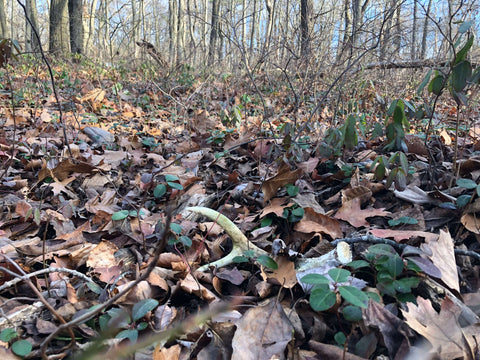5 Tips To Find More Sheds
Wouldn't it be nice if all the bucks lost their antlers on the same day? We all know about the bell curve of dropped antlers, even though social media makes it seem like there aren't any antlered bucks left.
There are so many written and rewritten articles, blog posts, videos, and vlogs about the search for sheds that it's hard to find one that works. But freshening up your ideas of shed hunting, sticking to fundamentals, and then putting rubber soles to the dirt is a good head start.
What are some fundamentals? Is there a way to find a few more pieces of headgear? Why is it always more challenging than it sounds? Let's answer these questions right now.
1. Hunt Where the Sheds Are...Not Where They Ain't

Ever wonder why there were plenty of bucks on your trail cams, but you can't seem to find their antlers? You'd think that you should be tripping over them. The answer is simple; bucks aren't there when their antlers drop.
Deer sign might be present in the area. It might even appear that the site is shredded. You have to imagine when the making of that sign took place. Pre-rut deer sign won't help you find antlers in the post-season. Consider the type of food deer are after, or check out the latest weather trends. Deer won't search for white oak acorns in February; they will seek the leftovers. Green briar, fern bulbs, random woody browse, or waste grain left by a combine are food types that can sustain a wintering buck.
Mild winters may find bucks keeping to themselves across a wide landscape. In those mild conditions, you'll find that bucks will travel further to look for the most appealing food. In freezing weather, bucks will group up, and just about any calorie-dense food will do. Also, in colder winters, bucks will prefer the warmest cover they can find. Those are the years to search on south and south-east facing slopes with thick cover or pine forests.
2. Tackle the Easy Spots First and Last
There are better descriptive words than "easy," but there are a few predictable spots to find sheds. If you're currently digging through articles on sheds, you'll read about one or more of these spots. There are fence crossings, creek crossings, military crests of long ridges, bedding cover, soft edges, hard edges, waterway ditches through fields, brush points, bottle necks, ridge saddles, etc. Notice a trend? There are A LOT of "predictable" pathways to take.
Scouting the property beforehand is the best approach to finding the "easy spots" where you hunt. E-scouting can play into your plan if you have yet to hike where you're going, but start small! Backtrack your scouting from the biggest food source you can find. If you know the big woods food, that's a bonus. Otherwise, the closest ag you can see will work. Find a handful of funnel types around that food, such as the most likely bedding cover and a creek bed where you can find multiple crossings. Work those areas around the food first. In those places, you'll find the "easiest" sheds in the woods.
3. Mark-Up Maps for New Properties
With a few free days on your hands, go opposite to what I just finished saying. Mark every waypoint on the parcel where you plan to look for antlers. Every predictable spot you can travel to will only up your odds of finding multiple sheds.
The important part of shed hunting large properties over a few days is to make a route. Of course, deer can return to areas where you might have been yesterday, but you're not looking for maybes. Make your path direct from one waypoint to the next, hitting new points on the way in and new ones on the way out. Use specific icons or colors so you know what type of ground you're looking for on the fly.
4. Don't Skip Pressured Spots
I spend most of my time looking for antlers on public land, and the largest shed I've found is 54 inches. Why do I bother mentioning the inches? Well, it's less about the inches than it is about where I found that antler. It was 150 yards behind a game commission building in an almost bare clover field. I saw it from about 75 yards away, tines up, waiting for someone to pick it up. Along with that antler, my buddy and I picked up two more sheds in that same field, one only a few steps from the parking.
I'm making this point: some spots you think may get searched regularly might be the overlooked antler spot. Plenty of hardcore shed people drove past that field, thinking it was a waste of time. Also, the building where that shed was lying is an active place of work. Places like public parks and where people walk their dogs, those areas are as likely to hold antlers when many needs of a deer are close by. You might be missing something if you're not looking in obvious places.
5. Now Get Out and Find Some Sheds
We are now entering the beginning of antler-drop. Social media would make it appear that we are in the peak shed season, but the best is yet to come. My latest shed strategy is to check a few fields and easy spots deer use at night. If you're the first person there in the morning, there's a good chance of picking up one or two pieces of white gold. And fortunately for me, I get to spend that time with my wife because she likes outdoor exercise just about as much as I do.
Author: Aaron Hepler, Exodus Black Hat Team Member





